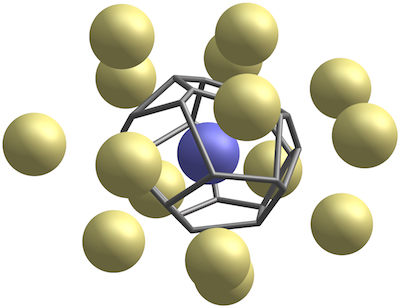Version 0.4
Version 0.4 was released on November 8, 2017, adding several new features (including one to resolve indeterminate types), fixing small bugs, and generally improving perherformance.
VoroTop code can be obtained directly from the GitHub repository using git by typing:
git clone https://github.com/VoroTop/VoroTop.git VoroTop
An implementation of VoroTop is now available in the latest development version of OVITO.
Filters
Filters specify sets of Voronoi topologies associated with particular structure types. Each filter is stored in a text-based format. Structure types are specified at the beginning of the file; structure types always labeled by increasing integer values starting at 1. Subsequent lines specify topological types (as recorded through Weinberg vectors) and their associated structure types.
In creating an AtomEye cfg file, VoroTop uses a filter to determine the structure type of each particle. Particles with topological types not included in the filter are considered defects and are assigned structure type 0.
Below are provided filters for several common structure types. Please be in touch if you are interested in generating additional ones not listed here.
| Filter name | Structure | Notes | |
|---|---|---|---|
| BCC | 1 | BCC | Identifies particles with body-centered cubic (BCC) local structure; ignores all other structure types. |
| FCC | 1 | FCC | Identifies particles with face-centered cubic (FCC) local structure; ignores all other structure types. |
| HCP | 1 | HCP | Identifies particles with hexagonal close-packed (HCP) local structure; ignores all other structure types. |
| ICOS | 1 | ICOS | Identifies particles with icosahedral local structure; ignores all other structure types. |
| FCC-HCP | 1 2 | FCC HCP (non-FCC) |
Designed for studying FCC systems with HCP-type defects (e.g., dislocation, twin planes, and stacking faults). |
| HCP-FCC | 1 2 | HCP FCC (non-HCP) |
Designed for studying HCP systems with FCC-type defects (e.g., dislocation, twin planes, and stacking faults). |
| FCC-both-HCP | 1 2 3 | FCC FCC/HCP HCP |
Designed to study systems with both FCC and HCP local structure. |
| FCC-BCC-ICOS-HCP | 1 2 3 4 5 | FCC BCC ICOS FCC/HCP HCP |
Designed to study general systems which may contain different structures. |
| TwoD | 1 2 3 4 5 6 7 8 9 10 |
triangles quadrilaterals pentagons hexagons 7-gons 8-gons 9-gons 10-gons 11-gons 12-gons |
Designed to study two-dimensional systems that are simulated inside a three-dimensional space. A particle with n Voronoi neighbors thus has the topology of a prism over an n-gon. |
| B123 | 1 2 3 4 | BCC B1 B2 B3 |
Identifies three ∑5 symmetric tilt boundaries in a BCC bicrystal; we (arbitrarily) call them B1, B2, and B3. |
| FILTERS IN DEPRECATED FORMAT | ||
| Filter name | ID | Description |
|---|---|---|
| BCC.filter | 0 | 1 BCC type |
| FCC_C_types.filter | 0 | 6,294 FCC types |
| HCP_C_types.filter | 0 | 21,611 HCP types |
| FCC_and_HCP_C_types.filter | 0 1 2 | 4,919 types of FCC but not HCP 1,375 types of FCC and HCP 20,236 types of HCP but not FCC |
| FCC_BCC_both_HCP_C_types.filter | 1 2 3 4 | 4,919 types unambiguously FCC 1 type of BCC (also FCC and HCP) 1,374 types in FCC/HCP overlap 20,236 types unambiguously HCP |
| B123.filter | 0 1-3 4-5 6-11 | 1 BCC type 3 B1 types 2 B2 types 6 B3 types |
Feedback
This software is currently in initial stages of development. Please feel free to be in touch with questions, comments, requests, or other suggestions for improvement. Also, if you are interested in collaborating on interesting research projects, please be in touch.
Related Software
The following software packages can be used in conjunction with VoroTop:
| Voro++ | A software library for computing three-dimensional Voronoi tessellations, developed by Chris Rycroft (Harvard). | ||
| OVITO | A visualization and analysis software package for atomistic data, developed by Alexander Stukowski (TU Darmstadt, Germany). | ||
| AtomEye | An atomistic configuration viewer, developed by Ju Li (MIT). |
